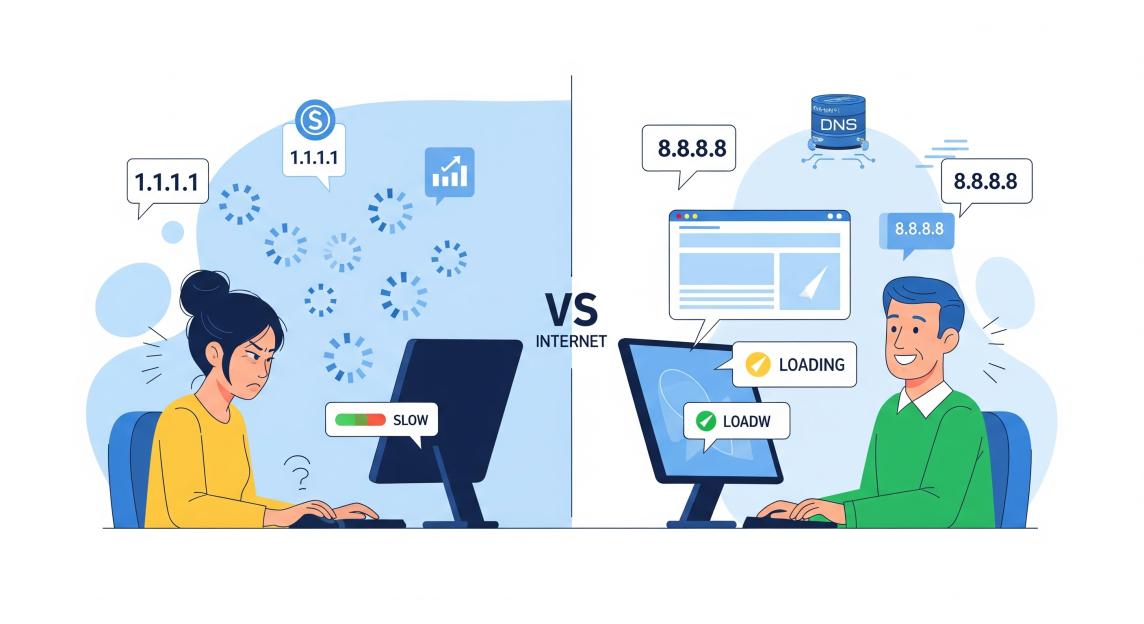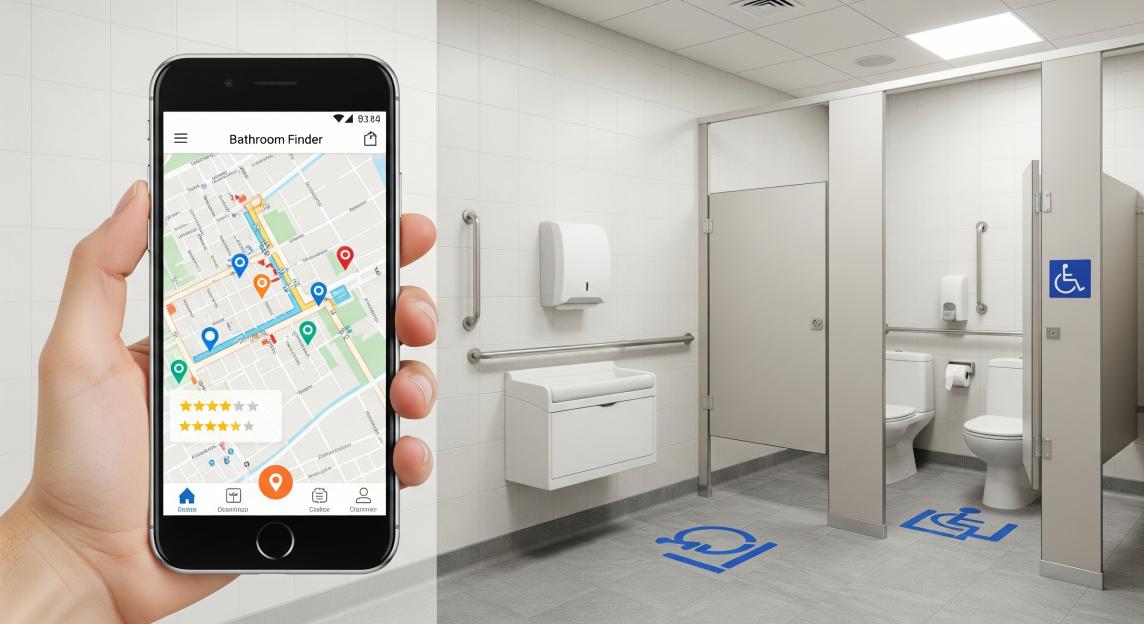You click on a website link, and instead of the lightning-fast response you expect, you’re stuck watching that spinning wheel of digital frustration. Your internet speed is blazing fast according to your provider, yet websites crawl to load. The culprit might not be your connection-it could be something invisible working behind the scenes that most people never think about.
Your DNS server is like the internet’s phone book, and if it’s slow or unreliable, every single thing you do online suffers. The good news? Changing it takes just minutes and can transform your entire browsing experience.
What Is a DNS Server and Why Should You Care?
Think of the internet as a massive city with billions of addresses. When you type “google.com” into your browser, your computer doesn’t actually know where to find Google’s servers. That’s where DNS (Domain Name System) comes in-it’s like having a super-efficient GPS that instantly translates “google.com” into the actual numerical address (IP address) where Google lives on the internet.
Your internet service provider (ISP) automatically assigns you their DNS servers when you connect to the internet. While these work, they’re often not the fastest or most secure option available. Many ISP DNS servers are overloaded, poorly maintained, or even track your browsing habits for advertising purposes.
By switching to a better DNS service, you can:
- Speed up your internet browsing by reducing the time it takes to look up website addresses
- Improve your security with built-in protection against malicious websites
- Enhance your privacy by preventing ISPs from tracking your browsing
- Access blocked content in some regions
- Reduce downtime with more reliable servers
The Top DNS Servers You Should Consider in 2025
1. Cloudflare DNS (1.1.1.1) - The Speed Champion
Cloudflare’s public DNS service has consistently ranked as one of the fastest DNS resolvers globally. Their primary servers are:
- Primary: 1.1.1.1
- Secondary: 1.0.0.1
Why choose Cloudflare DNS:
- Extremely fast response times
- Strong privacy policy-they don’t log your browsing data
- Built-in security features
- Free service with no ads
- Global network for consistent performance
Best for: Users who prioritize speed and privacy
2. Google Public DNS (8.8.8.8) - The Reliable Giant
Google’s DNS service is one of the most widely used alternative DNS servers worldwide:
- Primary: 8.8.8.8
- Secondary: 8.8.4.4
Why choose Google DNS:
- Excellent uptime and reliability
- Fast response times
- Advanced security features
- Easy to remember addresses
- Integration with Google’s global infrastructure
Best for: Users who want reliability and are comfortable with Google’s ecosystem
3. OpenDNS (208.67.222.222) - The Family Guardian
OpenDNS offers both free and premium DNS services with robust filtering options:
- Primary: 208.67.222.222
- Secondary: 208.67.220.220
Why choose OpenDNS:
- Excellent parental controls and content filtering
- Phishing and malware protection
- Customizable blocking categories
- Detailed usage statistics
- Good performance and reliability
Best for: Families and users who want content filtering and security features
4. Quad9 (9.9.9.9) - The Security Specialist
Quad9 focuses heavily on security and threat protection:
- Primary: 9.9.9.9
- Secondary: 149.112.112.112
Why choose Quad9:
- Automatic blocking of malicious domains
- No logging of personal data
- Threat intelligence from multiple sources
- Free service with no ads
- Non-profit organization backing
Best for: Security-conscious users and businesses
5. Comodo Secure DNS - The Complete Protection Package
Comodo offers comprehensive DNS protection:
- Primary: 8.26.56.26
- Secondary: 8.20.247.20
Why choose Comodo Secure DNS:
- Real-time malware protection
- Phishing site blocking
- Botnet protection
- Fast global network
- Additional security layers
Best for: Users who want comprehensive online protection
How DNS Servers Affect Your Internet Speed and Security
Speed Impact
Your DNS server choice directly affects how quickly websites load. Here’s what happens when you visit a website:
- You type a web address
- Your computer asks the DNS server for the IP address
- The DNS server responds with the address
- Your browser connects to the website
If steps 2 and 3 are slow, everything else waits. A fast DNS server can reduce this lookup time from hundreds of milliseconds to just a few milliseconds, making your browsing feel snappier.
Security Benefits
Modern DNS services offer several security advantages:
- Malware blocking: Prevents connections to known malicious websites
- Phishing protection: Blocks fake websites designed to steal your information
- Botnet protection: Stops malware from communicating with command servers
- Safe search enforcement: Filters inappropriate content for families
Privacy Considerations
Different DNS providers have varying privacy policies:
- No logging: Services like Cloudflare and Quad9 don’t store your browsing data
- Limited logging: Some providers log data for security but delete it regularly
- Full logging: Your ISP typically logs all DNS requests indefinitely
Step-by-Step Guide: How to Change Your DNS Server
For Windows 10/11 Users
- Open Network Settings
- Right-click the network icon in your system tray
- Select “Open Network & Internet settings”
- Access Adapter Options
- Click “Change adapter options”
- Right-click your active connection (Wi-Fi or Ethernet)
- Select “Properties”
- Configure DNS Settings
- Double-click “Internet Protocol Version 4 (TCP/IPv4)”
- Select “Use the following DNS server addresses”
- Enter your preferred DNS servers
- Click “OK” to save changes
- Flush DNS Cache
- Open Command Prompt as administrator
- Type:
ipconfig /flushdns - Press Enter
For Mac Users
- Open System Preferences
- Click the Apple menu
- Select “System Preferences”
- Click “Network”
- Select Your Connection
- Choose your active connection (Wi-Fi or Ethernet)
- Click “Advanced”
- Configure DNS
- Go to the “DNS” tab
- Click the “+” button to add new DNS servers
- Enter your preferred DNS addresses
- Click “OK” and then “Apply”
For Router Configuration (Affects All Devices)
- Access Router Settings
- Open a web browser
- Type your router’s IP address (usually 192.168.1.1 or 192.168.0.1)
- Log in with your admin credentials
- Find DNS Settings
- Look for “Internet,” “WAN,” or “Network” settings
- Find the DNS configuration section
- Update DNS Servers
- Change from “Automatic” to “Manual”
- Enter your preferred DNS servers
- Save and restart your router
Testing Your DNS Performance
After changing your DNS servers, you should test the performance to ensure you’ve made an improvement:
Speed Testing Tools
- DNS Benchmark Tools
- Use tools like DNS Jumper or Namebench
- These test multiple DNS servers and show response times
- Run tests at different times of day for accurate results
- Online Speed Tests
- Visit websites like DNSPerf.com
- Compare response times for different DNS providers
- Check both speed and reliability metrics
- Simple Browser Test
- Clear your browser cache
- Visit various websites and note loading times
- Compare before and after changing DNS
What to Look For
- Response time: Lower is better (measured in milliseconds)
- Reliability: Consistent performance across multiple tests
- Geographic relevance: Servers closer to your location often perform better
DNS Security Features You Should Know About
Malware and Phishing Protection
Many DNS services now include security features that protect you from online threats:
- Real-time threat intelligence: Constantly updated lists of malicious domains
- Automatic blocking: Prevents access to known dangerous websites
- Safe redirects: Takes you to warning pages instead of malicious sites
Family-Friendly Filtering
For households with children, DNS-based content filtering offers:
- Category blocking: Block entire categories like adult content or gambling
- Time-based restrictions: Different rules for different times of day
- Custom whitelists: Allow specific sites even if they’re in blocked categories
Business Security Features
Enterprise DNS solutions provide:
- Advanced threat protection: More sophisticated malware detection
- Policy enforcement: Ensure employees follow internet usage policies
- Detailed reporting: Monitor and analyze internet usage patterns
Common DNS Problems and Solutions
Issue 1: Slow Website Loading
Symptoms: Websites take a long time to start loading, but once they start, they load quickly
Solution:
- Test different DNS servers to find the fastest for your location
- Consider using DNS servers with global networks like Cloudflare or Google
Issue 2: Can’t Access Certain Websites
Symptoms: Some websites won’t load at all, showing DNS errors
Solutions:
- Try a different DNS server
- Check if your DNS provider blocks certain content
- Temporarily switch to a basic DNS like Google’s 8.8.8.8
Issue 3: Inconsistent Performance
Symptoms: Sometimes websites load fast, sometimes slow
Solutions:
- Use DNS servers with multiple IP addresses for redundancy
- Configure both primary and secondary DNS servers
- Consider your ISP’s DNS servers might be overloaded
Issue 4: Gaming or Streaming Issues
Symptoms: High latency in online games or buffering in streaming services
Solutions:
- Choose DNS servers with low latency
- Test gaming-optimized DNS services
- Consider using your router’s DNS settings for consistent performance
Advanced DNS Configuration Tips
Using Multiple DNS Servers
Configure both primary and secondary DNS servers for better reliability:
- If the primary server is unavailable, your computer automatically uses the secondary
- Mix different providers for redundancy (e.g., Cloudflare primary, Google secondary)
IPv6 DNS Configuration
For future-proofing and potentially better performance:
- Cloudflare IPv6: 2606:4700:4700::1111 and 2606:4700:4700::1001
- Google IPv6: 2001:4860:4860::8888 and 2001:4860:4860::8844
DNS Over HTTPS (DoH) and DNS Over TLS (DoT)
These newer protocols encrypt your DNS requests:
- Benefits: Prevents ISPs and others from seeing your DNS queries
- Setup: Available in modern browsers and operating systems
- Considerations: May be slightly slower due to encryption overhead
Choosing the Right DNS Server for Your Needs
For General Home Use
Recommendation: Cloudflare (1.1.1.1)
- Fast performance
- Strong privacy policy
- Easy to set up and remember
For Families with Children
Recommendation: OpenDNS (208.67.222.222)
- Built-in content filtering
- Parental controls
- Customizable blocking options
For Security-Conscious Users
Recommendation: Quad9 (9.9.9.9)
- Automatic malware blocking
- No data logging
- Focus on threat protection
For Gamers
Recommendation: Test multiple options
- Try Cloudflare, Google, and your ISP’s DNS
- Use gaming-specific benchmarks
- Consider latency over pure speed
For Businesses
Recommendation: Enterprise DNS solutions
- Consider paid services like OpenDNS Umbrella
- Look for advanced security features
- Evaluate reporting and management tools
Monitoring and Maintaining Your DNS Setup
Regular Performance Checks
- Test DNS performance monthly
- Monitor for changes in speed or reliability
- Keep backup DNS servers configured
Staying Updated
- Follow DNS provider announcements
- Update IP addresses if providers change them
- Consider new providers as they emerge
Troubleshooting Tools
Keep these tools handy for DNS issues:
- nslookup: Command-line tool for DNS queries
- dig: More detailed DNS lookup tool (Mac/Linux)
- DNS Benchmark: Software for comparing DNS performance
The Future of DNS Technology
Emerging Trends
- DNS over HTTPS (DoH): Increasing browser support
- DNS over TLS (DoT): Growing adoption for privacy
- AI-powered filtering: Smarter threat detection
- Edge computing: Faster response times through distributed networks
What This Means for Users
- Better privacy and security by default
- Faster performance through improved infrastructure
- More sophisticated filtering and protection options
- Easier configuration as operating systems improve DNS management
Conclusion: Making the Switch to Better DNS
Changing your DNS server is one of the simplest yet most effective ways to improve your internet experience. Whether you’re looking for faster browsing, better security, or family-friendly filtering, there’s a DNS solution that fits your needs.
Start with these recommendations:
- Try Cloudflare (1.1.1.1) for the best balance of speed and privacy
- Use OpenDNS if you need content filtering for your family
- Choose Quad9 if security is your top priority
- Test multiple options to find what works best in your location
Remember, you can always change back to your ISP’s DNS servers if you encounter any issues. The process is completely reversible, and experimenting with different providers costs nothing but a few minutes of your time.
Take action today-your faster, more secure internet experience is just a few clicks away. Your browsing speed, online security, and digital privacy will thank you for making this simple but powerful change.






